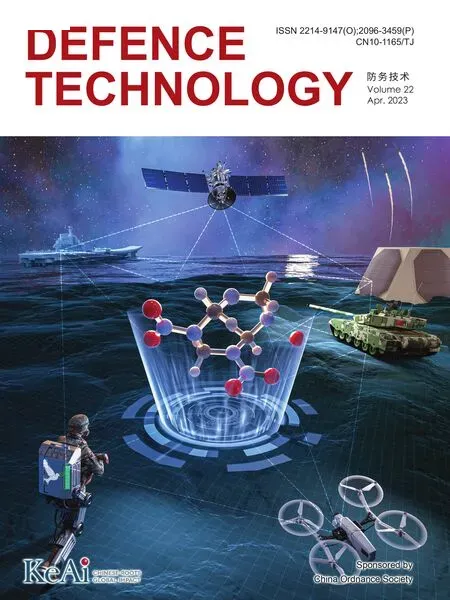Electrophoretic deposition of hybrid organic-inorganic PTFE/Al/CuO energetic film
2023-05-06YanjunYinFengHuLehuaChengXiaodongWang
Yan-jun Yin,Feng Hu,Le-hua Cheng,Xiao-dong Wang
School of Chemistry and Material Engineering,Chaohu University,Chaohu,238000,China
Keywords:Energetic film Electrophoretic deposition Fluorine-based polymers Combustion performance Thermite
ABSTRACT Thermite films are typical energetic materials(EMs)and have great value in initiating explosive devices.However,research in thermite film preparation is far behind that of research in thermite powders.Electrophoretic deposition (EPD) is an emerging,rapid coating method for film fabrication,including of energetic composite films.In this work,a polytetrafluoroethylene (PTFE)/Al/CuO organic-inorganic hybrid energetic film was successfully obtained using the above method for the first time.The addition of lithocholic acid as a surfactant into the electroplating suspension enabled PTFE to be charged.The combustion and energy release were analyzed by means of a high-speed camera and differential scanning calorimetery (DSC).It was found that the combustion process and energy release of PTFE/Al/CuO were much better than that of Al/CuO.The main reason for the excellent combustion performance of the hybrid PTFE/Al/CuO system was that the oxidability of PTFE accelerated the redox reaction between Al and CuO.The prepared PTFE/Al/CuO film was also employed as ignition material to fire a B—KNO3 explosive successfully,indicating considerable potential for use as an ignition material in micro-ignitors.This study sheds light on the preparation of fluoropolymer-containing organic-inorganic hybrid energetic films by one-step electrophoretic deposition.
1.Introduction
Thermites are a kind of energetic material (EM) with high energy,high insensitivity,good safety,excellent combustion performance,and high energy density[1,2].These characteristics make it suitable for applications in the military and civil fields,such as composite material manufacturing,metal welding,and solid rocket propellant[3].The film form of thermite,which is called energetic bridge film,is well suited for initiating explosive devices [4].However,research on thermite film is far behind that of the preparation methods and properties of thermite powder,which significantly limits its application in energetic devices [5].
To the best of our knowledge,the fabrication of energetic films has been mainly realized by means of atomic layer deposition(ALD)[6],sputtering,and pulsed laser deposition[7].These methods not only can control the thickness and dimensions precisely,but also have the advantage of enhanced contact.Oxidizers and fuels have been used to prepare core/shell structure and reactive multilayer nanofoils to achieve high performance using such strategies [1,5].Theoretically,sputtering metals and alloys with a magnetron target source is not that difficult owing to the formation of loops between the target(cathode),plasma,and splashed part/vacuum cavity[8].One issue is that it is difficult to deposit films for insulators via magnetron sputtering.Particularly,organic matter would be carbonized easily during magnetron sputtering granulation,which limits the application range of thin film material preparation.Another issue is that the devices for sputtering or ALD are generally expensive[9].Thus,it is important to develop a facile procedure for fabricating energetic film at a low cost and with organic matter compatibility.
In recent decades,electrophoretic deposition (EPD),as an emerging rapid coating method,has been extensively studied for film fabrication,including of energetic composite films [10].This flexible technique only requires low-cost equipment to assemble different films at room temperature in a straightforward manner.In our previous studies,nano-thermite films have been constructed via EPD from an aqueous suspension system [11]and an organic solvent suspension system [12,13].The adhesion and combustion performance of the deposited energetic film can be controlled by tuning the parameters or introducing additives during EPD[14,15].
For thermites,aluminum is prone to agglomerate and contain a larger fraction of an inert shell of Al2O3[16].Taking a 50 nmdiameter nano-Al particle as an example,an Al2O3shell (approximately 2 nm thick)forms outside the particle,which occupies 30%of the total nano-Al mass[17].The dead Al2O3shell layer can reduce the combustion performance of thermites severely.Therefore,it is of interest to improve the combustion performance of thermites by tuning its components.Carbon-containing materials have recently demonstrated the ability to lower the ignition energy and increase the energy release rate of energetic materials[18,19].These carboncontaining materials are typically graphene oxide [20],graphene fluoride [17],and fluorine-based polymers [21,22].Particularly,fluorine-based polymers are excellent oxidizers with respect to forming AlF3between F and Al,even in dead Al2O3.The AlF3intermediate has a lower boiling temperature than Al2O3,which can facilitate the exposure of fresh Al for further reaction[23].Besides that,fluorine-based polymers also can act as binders to enhance the mechanical integrity of energetic composites.
Although many energetic systems have been made with fluorine-based polymers,most of them are in powder form[21,24].Thermite films with fluorine-based polymers are rarely reported.Given the abovementioned advantages of EPD and fluorine-based polymers,we present a successful attempt to construct thermite films using Al/CuO as an example via EPD with polytetrafluoroethylene(PTFE)as additives,which has the highest fluorine content among fluorine-based polymers and is largely insoluble in common solvents [23].
2.Experiment
2.1.Preparation of PTFE/Al/CuO energetic composite thin film
Firstly,the reagents and materials used in this work were purchased commercially without any further processing including nano-Al(50—100 nm,99.9%,activity 93.5%,Guangxi Hongwu Nano Technology Co.,LTD),CuO (40—100 nm,99.5%,Aladdin),PTFE(20 μm,99%,Dupont 7AX)and isopropanol(AR.,99%,Aladdin).The EPD process was used to fabricate the energetic composite thin film.Briefly,0.05 g nano-Al,0.1 g CuO,and 0.04 g PTFE were mixed with 50 mL isopropanol.Then,a 1 mL ethanol solution of anionic biosurfactant lithocholic acid(LCA,1 wt.%)was added to the above mixture for the dispersion of neutral PTFE,followed by a 10 min sonication to obtain a uniform suspension.Two precleaned copper foils were immersed into the suspension 1 cm apart at a voltage of 150 V for 5 min.After EPD,the copper foil covered with composite was dried under vacuum for 12 h.Fig.1 shows the complete preparation procedure for the PTFE/Al/CuO film.
2.2.Characterizations
Infrared (IR) spectra were acquired via an FT-IR spectrometer(Niton Apollo LIBS,America) using KBr as the reference.X-ray diffraction(XRD)patterns were recorded in transmission mode on a Rigaku D/Max 2500 PC diffractometer (Cu Kα1 radiation).Scanning electron microscopy (SEM) images and energy-dispersive Xray(EDX)maps were obtained on a Hitachi SU8010 and Zeiss Smart EDX,respectively.Additionally,differential scanning calorimetry(DSC,STA449F3,Germany) was used to characterize the heat release of the reaction from 30 to 1000°C in freestanding ceramic crucibles with a heating rate of 20°C/min in a 99.999% argon atmosphere.The zeta potential was measured by a Malvern Zetasizer Nano ZS90 (England).Each sample was tested three times in parallel.
2.3.Ignition experiments
In this study,the PTFE/Al/CuO energetic films was triggered by a laser device (HB-LID02).The laser emitted a 5 mm light spot at 60 W to one end of the PTFE/Al/CuO film,which causes the selfpropagating combustion of the energetic film.In addition,boron and potassium nitrate (B—KNO3) explosives was used to evaluate the initiation performance of the PTFE/Al/CuO coating.Generally,B and KNO3were ultrasonically mixed with 10 ml isopropanol in a 25/75 mass ratio.Then,B/KNO3powder was obtained by vacuum drying at 60°C.10 mg B/KNO3powder was placed on one end of PTFE/Al/CuO film,and the self-propagating combustion was triggered by laser from the other end of the film.The flames spread until the B/KNO3explosive was detonated.A standard optical ultrahighspeed industrial camera was employed to characterize the combustion performance via imaging the flame and calculating the sustained combustion rate.In addition,the flame burning rate is calculated by the following Eq.(1):
where thelis the length of PTFE/Al/CuO films;andtis the time required for the combustion process of energetic films after being triggered by laser.
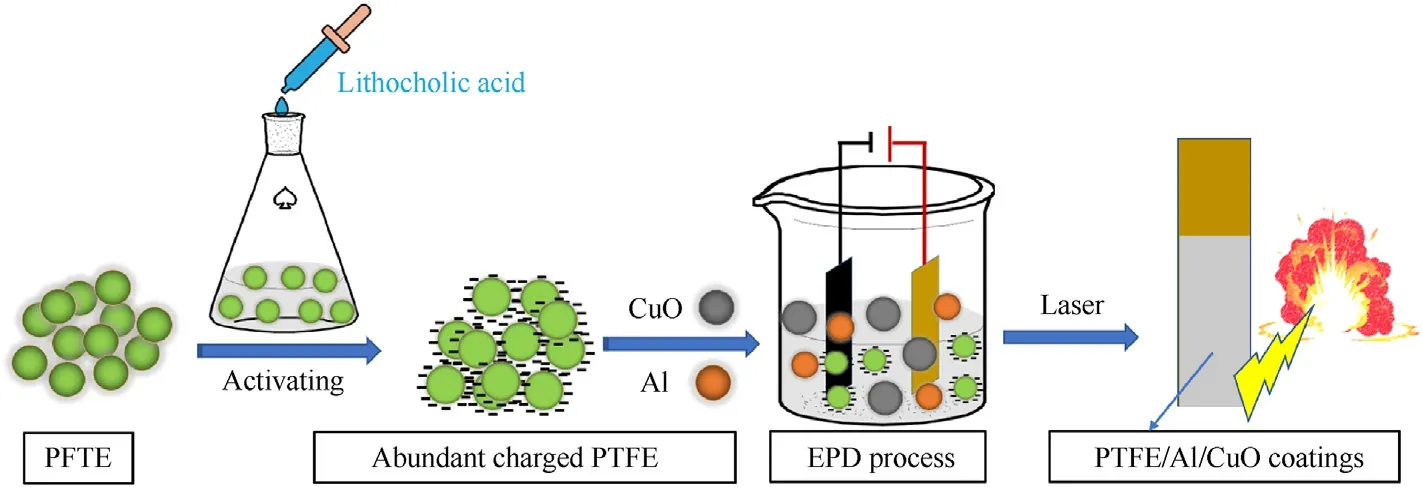
Fig.1.Schematic illustration of the preparation of PTFE/Al/CuO hybrid energetic composite films via EPD with the addition of lithocholic acid.
3.Experimental results and analysis
3.1.Structural characterization
The addition of a fluoropolymer can enhance the exothermic performance and combustion processes of inorganic energetic materials by forming hybrid reactive composites [25].PTFE is the most typical one owing to its highest fluoride content.In order to assemble the PTFE particles into an energetic film together with inorganic fuel (Al) and oxidizer (CuO) via a facile electrophoretic deposition process,the electrically neutral additive PTFE has to be dispersed and charged to form stable suspensions in a solvent.To do so,an anionic biosurfactant,lithocholic acid(LCA),is added into the mixture suspension system containing nano-Al,CuO,and PTFE in isopropanol [26].The additive amount of LCA is optimized to achieve a high absolute value of the zeta potential,which indicates a high stability of the suspension and high electrophoretic mobility[27].The suspension zeta potential values with different amounts of LCA are presented in Table 1 and Fig.2.It is found that the absolute zeta potential values increased after LCA was added.Furthermore,adding more LCA induced higher absolute zeta potential values.The results showed that LCA,as a surfactant added to the suspension,is wrapped on the surface of PTFE under the action of electrostatic force,so that the surface of PTFE had sufficient charge,which facilitated orderly migration and composite film formation under the electric field force drive.Besides the absolute zeta potential values changes,the zeta potential distribution peaks in Fig.2 also broadened by adding LCA.When 5 mL of LCA was added,although the absolute value of Zeta potential in the suspension increased to some extent with PTFE,two peaks appeared,indicating that the potential distribution of the suspension is not uniform.The main reason for this is speculated to be due to excessive LCA modification on the surface of PTFE increasing its weight,and the electrostatic repulsion between charged particles is not sufficient to make part of the particles suspended,destroying the stability of the suspension[28].Thus,we chose a 1 mL addition of LCA ethanol solution (experimental #3),which give a relatively high absolute zeta potential value and uniform suspension,for the following discussion.

Table 1 Different suspension compositions for EPD and corresponding zeta potentials.
Identifying the inorganic and organic components of the hybrid energetic composite thin film fabricated via EPD was first done by means of XRD.The deposited thin film was directly used without removal from the substrate to record XRD patterns.As presented in Fig.3(a),the representative diffraction peaks of CuO and Al are clearly detected in the as-deposited composite film.One weak Bragg peak at ca.18°is well indexed to characterize the reflection pattern of the crystalline PTFE,implying that PTFE was successfully deposited during the EPD process.Complementary,IR spectra were performed to reconfirm the presence of PTFE in the composite film.Obvious characteristic absorption peaks originating from CF2 bonds appeared from the composite film,as depicted in Fig.3(b).The peaks at 1155 cm-1and 1215 cm-1are associated with the CF2 symmetric stretching mode and asymmetric stretching mode,respectively [29].These results are in accordance with the XRD patterns.
Nano-aluminum spheres,copper oxide spheres,and trace bulk PTFE were uniformly co-deposited on the surface of pure copper,forming homogenous and smooth,dark-gray film without other impurities (See Fig.4(a)).In addition,the purchased PTFE is a blocky solid of approximately 20 μm in size,as seen in Fig.4(b).In the PTFE/Al/CuO system after the electrophoresis co-deposition process,except for nano-aluminum and copper oxide,the larger size of PTFE can be obviously observed.When combined with EDXenergy spectra,PTFE did coexist with nano-aluminum and copper oxide on the substrate in the form of thin film in Fig.4(c).PTFE,as macromolecules,can migrate effectively and attach to the surface of electrode substrate under the action of electric field force once charged.Thanks to the coating and modification of lithocholic acid surfactant,the surface of PTFE carries sufficient charge and migrates under the action of electric field force.
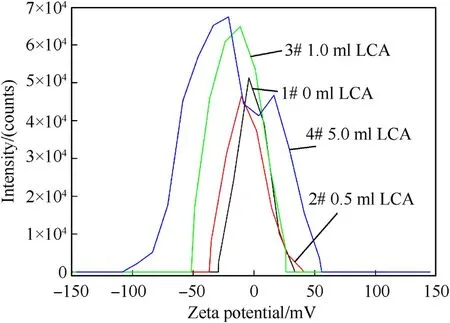
Fig.2.Zeta potential intensity distributions for the suspension with different LCA addition.
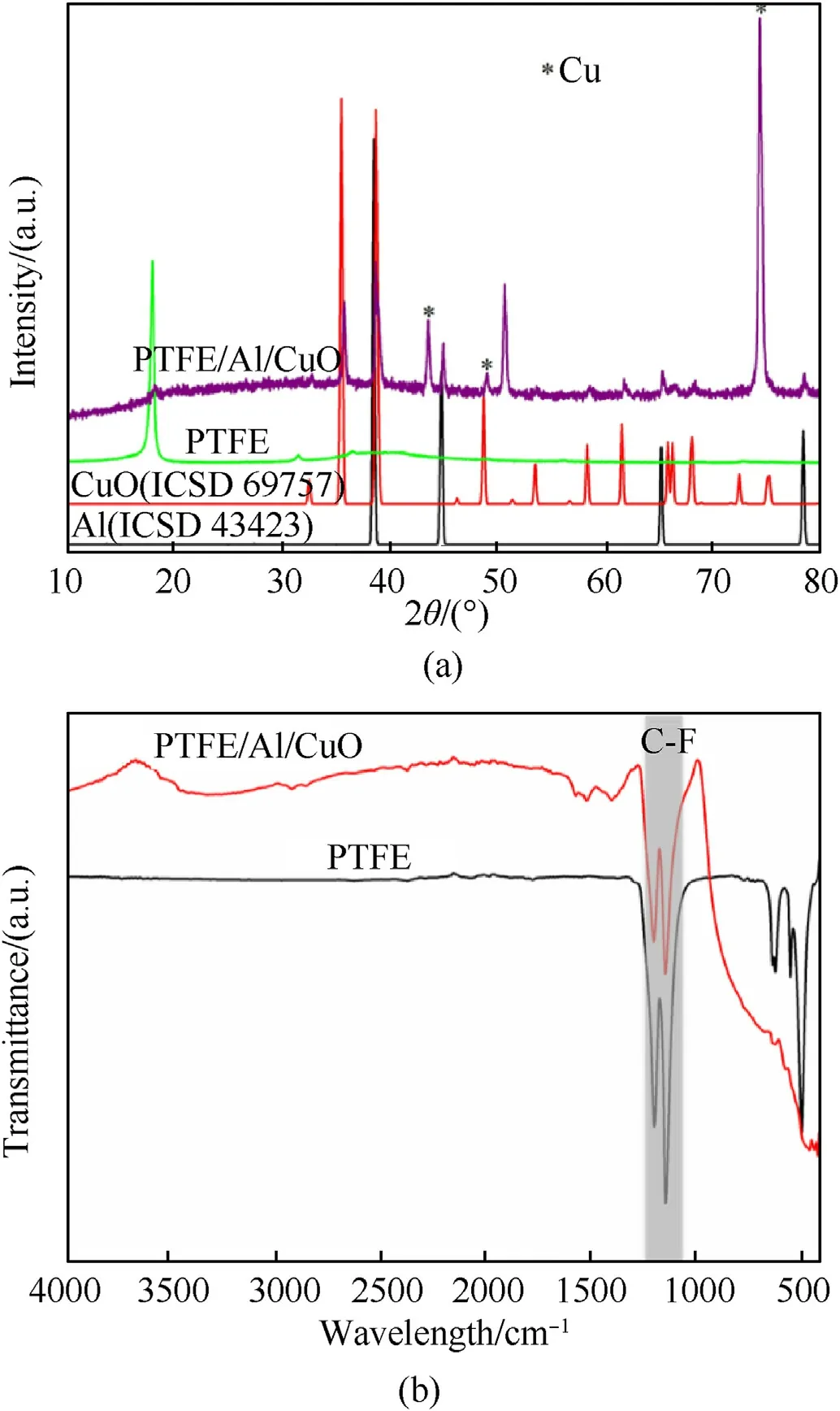
Fig.3.(a) Experimental XRD patterns of the PTFE/Al/CuO composite film and pristine PTFE,and simulated XRD patterns of CuO and Al;(b)IR spectra of pristine PTFE and asdeposited PTFE/Al/CuO composite film.
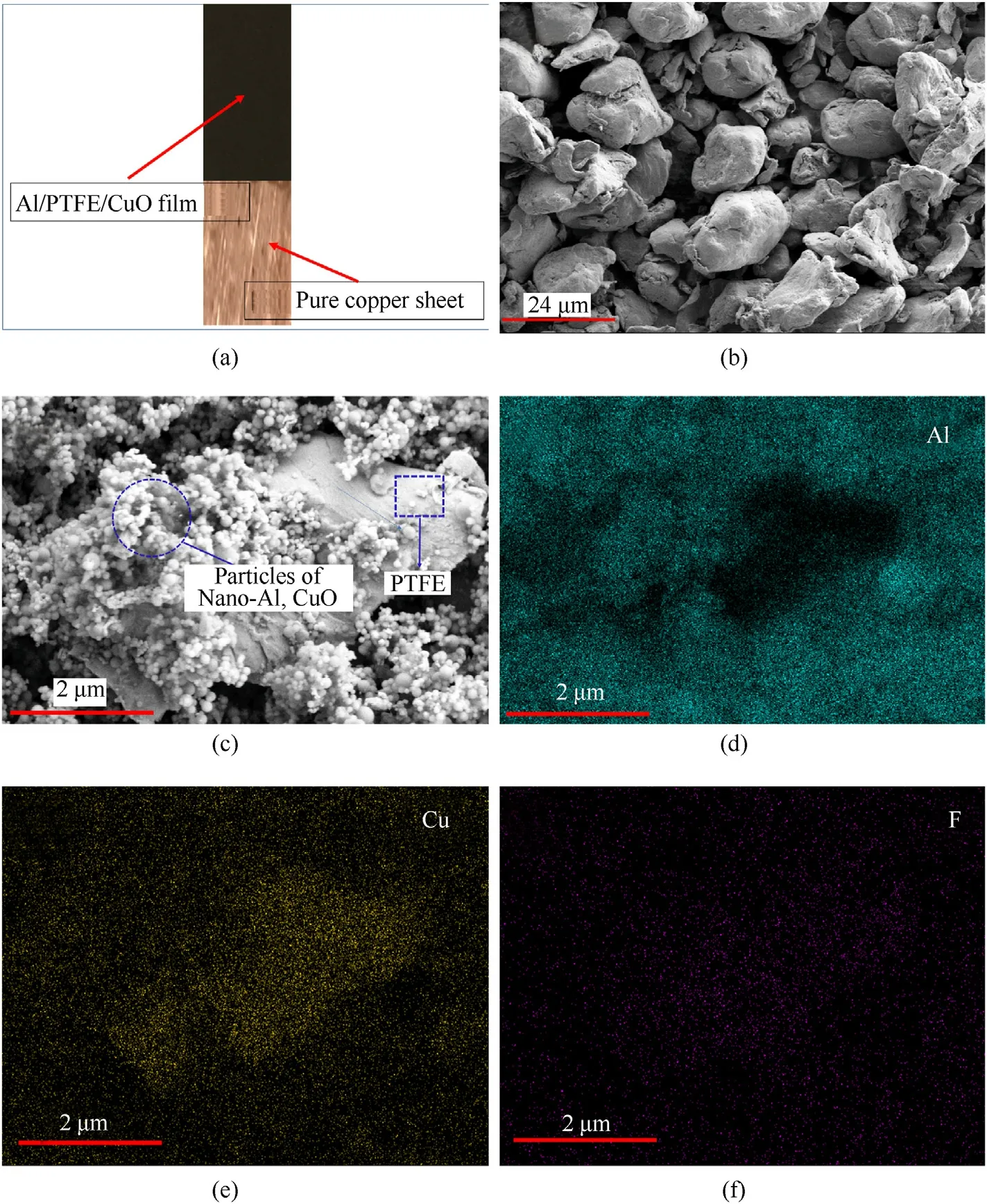
Fig.4.(a)The image of PTFE/Al/CuO films coating on the surface of pure copper;(b),(c)The typical SEM image of the purchased PTFE and PTFE/Al/CuO energetic materials;(d),(e),(f) the EDS spectrum of PTFE/Al/CuO.
3.2.Combustion performance
From the ignition experiment results in Fig.5,it can be seen that PTFE/Al/CuO burned more violently than Al/CuO.When PTFE/Al/CuO was triggered by a laser,the thermite reaction begun immediately,and the bright flame spread rapidly with a flame length of 2 cm (see Fig.5(b)—(d)).Under the same conditions,the flame length of the Al/CuO system after excitation is only approximately 1.5 cm,as shown in Fig.5(a).The flame length here is much shorter,and the combustion effect of Al/CuO was far inferior to that of the PTFE/Al/CuO system.The reason for this is that the existence of PTFE can form localized hot-spots and thus promote a reaction between Al and CuO to significantly enhance the combustion of Al.In Fig.5(c),the sample flame is the highest,and the flame spread fastest due to more PTFE deposited into the hybrid thermite film after adding the appropriate LCA solution.However,the main reason for the slight improvement of combustion intensity is that the content of PTFE in the Al/CuO composite did not increase significantly (see Fig.5(c)) compared with Sample 3,which is in accordance with the zeta potential results (Fig.2 and Table 1).Moreover,the combustion rate of energetic film samples was calculated according to formula (1).The length of PTFE/Al/CuO films deposited on copper substrate is about 3 cm,and the combustion time of the four samples after laser ignition is 53.5 ms(Fig.5(a)),22 ms (Fig.5(b)),14.3 ms (Fig.5(c)),15.4 ms (Fig.5(d)).Therefore,the combustion rates of the four samples are 0.56,1.35,2.1 and 1.95 m/s,respectively.
The heat release with or without the PTFE addition was quantitatively measured by TG-DSC under an atmosphere of argon.The quantitative heat release of the thermite was obtained by integrating the heat release curves(Fig.6).The highest heat releases of the composite film with different quantities of PTFE,achieved through adjusting the addition of LCA to 0,0.5,1.0,or 5.0 ml,are 4034,5673,8784,and 6536 J/g,respectively.These results indicate that PTFE can promote the energy release of an Al/CuO film dramatically,as seen in Sample 3,which is consistent in its combustion performance(Fig.5).

Fig.5.The combustion performance of Al/CuO prepared with different amounts of PTFE by adding variable doses of LCA: (a) 0.0 ml;(b) 0.5 ml;(c) 1.0 ml;(d) 5.0 ml.

Fig.6.The heat release of Al/CuO prepared with different amounts of PTFE by controlling the LCA volume (0,0.5,1.0,and 5.0 ml).
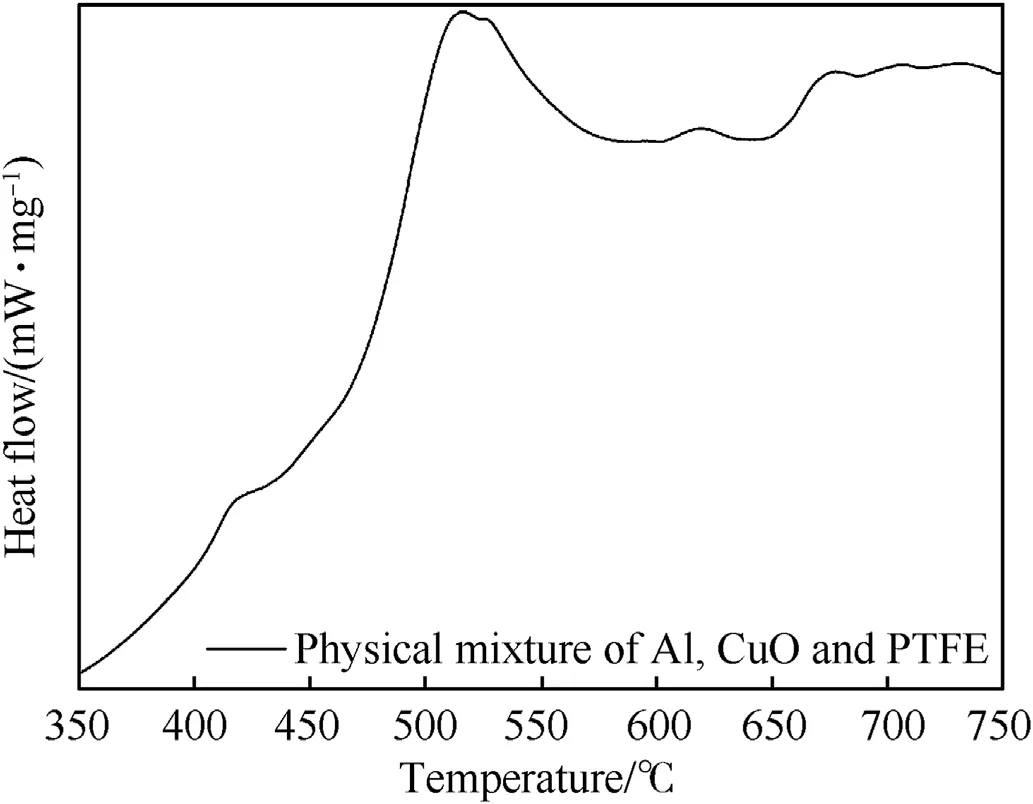
Fig.7.The heat release of physical mixture of Al,CuO,and PTFE.
It can also be seen that the PTFE/Al/CuO hybrid thermite manifested one more additional exothermic peak in the exothermic curve comparing to Al/CuO (Fig.6).The first exothermic peak of PTFE/Al/CuO appeared near 475°C,which was much lower that of the exothermic peak of Al/CuO.It has been reported that PTFE begins to decompose and produce gas at approximately 450°C,and it is speculated that the generated oxidizing gas will undergo a redox reaction with solid nano-Al to trigger thermite reaction at low temperatures [24].Once the nano-Al melts,the strong reaction between fresh Al and CuO would start,producing the second exothermic peak.

Fig.8.Schematic illustration of firing B—KNO3 explosive via PTFE/Al/CuO coating(right)and high-speed photographs of ignition of B—KNO3 via thermite PTFE/Al/CuO coating(left).
To verify the high energy release of PTFE/Al/CuO films obtained by EPD,a physical mixture of Al,CuO,and PTFE was prepared by the ultrasonic mixing of the solution.The DSC result is displayed in Fig.7.However,the exothermic curve of the physical mixtures behaves significantly differently from that of the PTFE/Al/CuO film,with two exothermic peaks.Both the first and second exothermic peaks were very gentle,leading to a low integral area with an energy release of 2482 J/g,which is far below than that of the PTFE/Al/CuO film.The advantages of EPD are proved again by the above results with regards to preparing high quality energetic film.The density,uniformity and contact area of the products obtained by the traditional physical method cannot be guaranteed,unlike with EPD,resulting in an uneven or even a slow reaction energy transfer of the system.
3.3.Firing of B—KNO3
B—KNO3(25/75),an explosive widely used in small-caliber rockets and as a pyrogen igniter for large motors,was employed to characterize the ignition performance of the as-deposited PTFE/Al/CuO coating.Compared to nitramine explosives such as cyclotrimethylenetrinitramine (RDX) and cyclotetramethylenetetranitramine (HMX),thermite-based energetic films are both safer and more insensitive when serving as ignition materials.A schematic illustration of firing B—KNO3is presented on the right side of Fig.8.The PTFE/Al/CuO coating was triggered from one side,and the B—KNO3explosive was placed on the other side of the PTFE/Al/CuO coating.The firing process of B—KNO3by PTFE/Al/CuO film was recorded and shown on the left side of Fig.8.The PTFE/Al/CuO selfpropagated quickly when ignited via an electrical process (please refer to SI Movie).A wider and more violent flame was observed(as marked in Fig.8,see SI Movie)when the flame reached the B—KNO3explosive,indicating that the B—KNO3explosive was fired successfully by the as-deposited PTFE/Al/CuO coating.These results highlight that the PTFE/Al/CuO coating has considerable potential for use as an ignition material in micro-ignitor applications.
4.Conclusions
In summary,we successfully fabricated a hybrid organicinorganic PTFE/Al/CuO energetic film by facile electrophoretic deposition technology.The electrically neutral PTFE was assembled into energetic film via EPD due to the addition of the biosurfactant lithocholic acid to the electroplating suspension.The introduction of the fluorine-based polymer PTFE into Al/CuO thermite film improved its combustion performance and heat release dramatically.The heat release of PTFE/Al/CuO reached 8784 J/g,corresponding to a combustion rate of 2.1 m/s,which was much higher than that of Al/CuO (4034 J/g).The reason was that PTFE,as a fluorine-based polymer with a high content of oxidizing element F,can consume inert Al2O3and expose fresh Al to reaction with CuO.Furthermore,the prepared PTFE/Al/CuO film was also employed as an ignition material to fire B—KNO3explosives successfully,indicating considerable potential for use as an ignition material in micro-ignitor applications.This work provides a new route to fabricate high performance hybrid organic-inorganic thermite film containing electrically neutral fluorine-based polymers.
Declaration of competing interest
The authors declare that they have no known competing financial interests or personal relationships that could have appeared to influence the work reported in this paper.
Acknowledgments
This work was supported by National Natural Science Foundation of China(No.21905032)and Natural Science Foundation of the Higher Education Institutions of Anhui Province(No.KJ2019A0687,No.KJ2016A503),High-level Humanities and Social Science Award Cultivation Project of Chaohu University and Innovation (No.kj20zkjp01,No.kj20xqyx02) and Entrepreneurship Training Program for Students of National and school level(No.202010380014,X202010380013).Y.Y.would like to thank Chaohu University for the Start-Up grant (No.KYQD-201907).The authors would like to thank Shiyanjia Lab (www.shiyanjia.com) for SEM and EDX mapping measurements.
杂志排行
Defence Technology的其它文章
- Hardware-in-loop adaptive neural control for a tiltable V-tail morphing aircraft
- Resilient tightly coupled INS/UWB integration method for indoor UAV navigation under challenging scenarios
- Microfluidic assisted 90%loading CL-20 spherical particles:Enhancing self-sustaining combustion performance
- Dual Attribute Adversarial Camouflage toward camouflaged object detection
- GO/HTPB composite liner for anti-migration of small molecules
- Benchmark calculations and error cancelations for bond dissociation enthalpies of X—NO2
